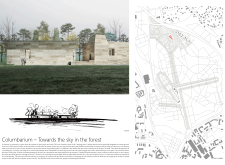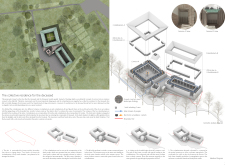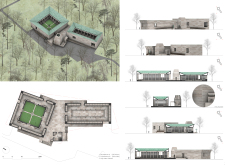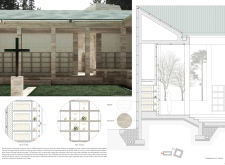5 key facts about this project
The design comprises two main structures, referred to as Columbarium-A and Columbarium-B, which collectively accommodate 500 niches. Each columbarium features distinct architectural elements that aim to integrate seamlessly with the surrounding landscape. The use of natural materials like travertine and marble highlights the project’s emphasis on warmth and durability. Glass panels incorporated into the design allow natural light to penetrate the interiors, creating a dynamic interaction between the built form and the outdoor environment. The use of copper for the roofing introduces a timeless quality, as its green patina signifies the passage of time.
The design approach taken in this project stands out for several reasons. Firstly, the emphasis on harmonization with nature sets it apart from conventional memorial sites. The positioning of the structures around a central courtyard fosters a communal experience, encouraging visitors to engage creatively with the space. The pathway system leading to the columbariums guides individuals through varied sensory experiences, enhancing reflection and contemplation.
Moreover, the sacramental niches are intentionally oversized, providing flexibility for the display of personal mementos alongside urns. This design consideration not only accommodates the practical needs of families but also encourages personalization of memorialization, enriching visitors' connections to their loved ones. The incorporation of communal gathering areas allows for memorial services, further reinforcing the project’s dual purpose as a space for remembrance and community interaction.
The columbarium project serves as a model for contemporary memorial architecture. Its thoughtful design integrates natural and built elements, promoting a respectful engagement with themes of life and death. For a comprehensive understanding of the design, readers are encouraged to explore the architectural plans and sections, revealing further details of the innovative principles and approaches employed in this project.


























